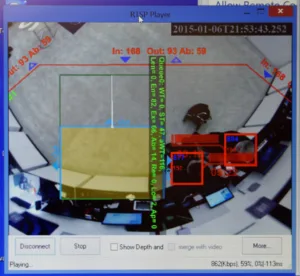Imagination’s image processing identifies people walking in an area and tracks their movements – ideal in retail environmentsImagination had a meeting room to demonstrate its latest ip cores. The company is, of course, well known for its cores for graphics, video and audio, as well as its acquisition of MIPS technologies at the end of 2012.
We started by looking at the 3D graphics supported by Open GL ES 3.1 software which enables console-level graphics. Of course, TVs now need good graphics and Imagination told us that several of the LG TVs at the show featured the company’s PowerVR GPU technology. There were plenty of other products with the technology including the Acer Iconia One 7, the HP Stream 8 and three of Lenovo’s Yoga tablet (and its P90 phone). It is also in the Dell Venue 8 7000 series tablet that we saw on the Intel booth (and which won prizes at the show)
The LG G3 was the first to have LG’s own Nuclum (that took some deciphering from my notes!) processor has a PowerVR Series 6 core and Imagination’s technology is low power enough to go into the Moto 360 (although according to iFixit, that watch includes an OMAP3630, a four year old chip).
Next, we got a look at the ray tracing that is in the PVR Wizard GPU family (Display Monitor Vol 21 No 12) Imagination has been developing ray tracing since acquiring Caustic in 2010. The demo showed a ray traced car which was impressive, but the scene didn’t look ray-traced. It turns out that this is deliberate – ray tracing uses a lot of processor power, so it can be applied on a “per object” basis. The car had a lot of curved surfaces and glass, making transparency and reflections important, so ray tracing is worthwhile.
The Imagination cores are highly scaleable from 1 to 16 cores, so they really can be used in systems from mobiles to consoles.
The Series 7 core was announced in November, but will not be seen in devices such as SoCs until Q4 of this year, with chips likely to be available in mass production in 2016. We enjoyed a powerful demo of using this GPU for compute purposes. It was being shown used in a vision processing app that analyses movements in retail stores. Overhead cameras can track individuals as they move around a store, allowing store owners to optimise store layout. The firm also has a Raptor core for image processing as well as its GPU and video cores. Imagination sees a lot of applications for image processing in automotive applications in the future.
The company believes it is now the top supplier of ip cores for video processing now. At the show, it was demonstrating H.265 encoding on its technology. The firm said that the 10 bit requirements of H.265 are tough on the processor and at the moment, the demonstration was being done on an FPGA as it’s a bit early for dedicated silicon.
Another demo was of four streams of 1080P video being rendered onto surfaces that could then be manipulated on the GPU as 3D objects. The demo was running on the Google Nexus.
Display Daily Comment
We expect to hear more from Imagination at Mobile World

